

CDP Systems Corp. 在飞秒技术、超快光谱学和近场扫描光学显微镜领域拥有 25 年的工作历史。
1988 年 7 月,我们报道了第一个飞秒多通道染料放大器,并将这种方法商业化在与碰撞脉冲锁模染料振荡器一起运行的设备中。
我们在 MPA 50 多通道 Ti:蓝宝石放大器系统中成功使用了这种双镜放大器配置。使用 TISSA 20 种子激光器,它可以在 1 kHz 脉冲重复率下有效放大 < 40 fs 的脉冲。我们的 MPA-XL 两级太瓦放大器系统在 10 Hz 脉冲重复率下提供 0.2 J 脉冲能量。
CDP Systems Corp. 成立时是一家制造用于飞秒现象研究的激光和诊断设备的公司。我们是第一家制造完整的超快光谱实验室的公司,包括用于飞秒荧光和瞬态吸收光谱的种子激光器、放大器和设备。
FOG100 荧光上转换系统和 ExciPro 瞬态吸收泵-探针系统是第一款专业的交钥匙飞秒光谱系统,可以在安装后立即获得科学结果。
我们的 MoScan-F 扫描光学显微镜平台与附加的近场光纤探头一起提供 < 50 nm 的空间分辨率。 MoScan-F 可适用于超快速荧光测量,并使 CDP Systems Corp. “单手”公司在光学测量中提供最佳时间和空间分辨率。
产品咨询:185 0219 3480
TISSA Series
One-box Femtosecond Ti:sapphire Lasers
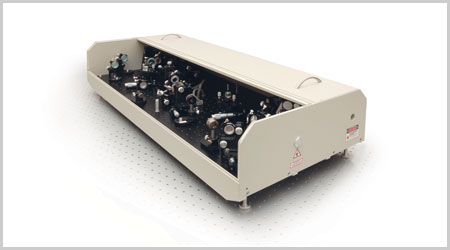
The TISSA is a series of mode-locked Ti: sapphire oscillators integrated with a pump laser.
The CDP Systems Corp. offers a full line of products, including two-output oscillator TISSA 20, recommended as a seed source for amplifier systems and two-colour TISSA 60GS and TISSA 100GS oscillators with on-board frequency doublers.
Features:
Built-in DPSS pump laser
Built-in extra-cavity prism compressor (TISSA 20)
Compressed and uncompressed outputs (TISSA 20)
Seed oscillator for amplifiers (TISSA 20)
Built-in USB spectrometer (TISSA 60S, TISSA 100S)
Built-in second harmonic generator (TISSA 60GS, TISSA 100GS)
Specifications:
| ||||||||||||||||||||||||||||||||||||||||||||||||||||||||||||
1) Two outputs of TISSA 20 don't work simultaneously
2) 800 nm - 900 nm tuning range with optional IR set of mirrors is available for TISSA 60 and TISSA 100
TISSA Series
Femtosecond Ti:sapphire Laser Kits
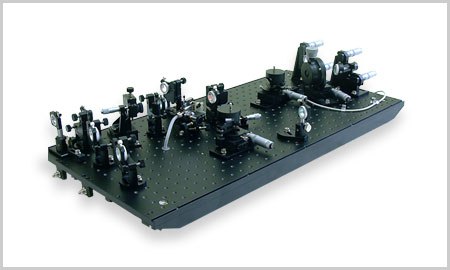
TISSA kits contain all components of femtosecond Ti: sapphire oscillator preinstalled and tested on a breadboard and supplied with a cover box.
TISSA 50 and TISSA 100 are most cost effective Ti: sapphire oscillators, which are "working horses" for multipurpose ultrafast applications.
Comparing with TISSA 50 oscillator, TISSA-L contains a cavity extension and is characterized by lower pulse repetition rate. It gives >15 nJ output pulse energy without cavity dumper
| ||||||||||||||||||||||||||||||||||||||||||||
1) DPSS or Ar-ion pump laser is required
2) At 800 nm output wavelength and with 5 W pump
MPA 50
Femtosecond Multipass Ti:sapphire Amplifier飞秒多通道钛:蓝宝石放大器
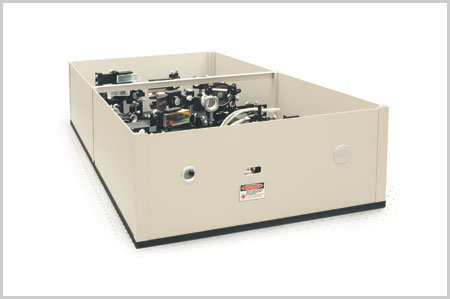
MPA 50 is a multipass Ti: sapphire amplifier based on a two-mirror confocal design and containing a pulse stretcher, a pulse compressor, a pulse picker, synchronization electronics, and the Faraday isolator.
A pump laser is placed outside the amplifier. Please, contact us about the best pump laser for 1 kHz and 10-50 Hz repetition rates.
Specifications:
Operation wavelength: 780 - 820 nm
Output pulse duration: < 40 fs1)
Output pulse energy at 1 kHz: 1 mJ
Output pulse energy at 10-50 Hz: 2 mJ
Output beam diameter: 4-8 mm
Output beam quality: M2<1.5
Output beam polarization: Horizontal
Pulse to pulse stability: <2 % rms
1) With the TISSA 20 seed oscillator
Dimensions:
1200 mm x 600 mm x 250 mm
MPA-XL
Femtosecond Terawatt Ti:sapphire Laser System
MPA-XL is a cost-effective terawatt Ti: sapphire amplifier system. It gives up to 200 mJ energy of the stretched pulse and further compression with 65% efficiency. A standard air compressor can be placed into a custom designed vacuum chamber.
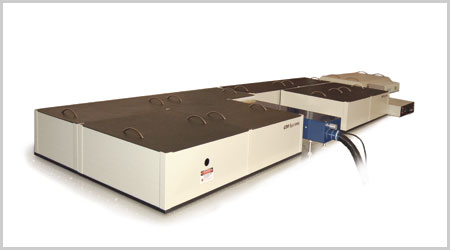
The system configuration:
TISSA 20 femtosecond Ti: sapphire seed oscillator with built-in pump laser
Femtosecond pulse stretcher
Two-mirror confocal multipass first stage amplifier with a pump laser
4-pass second stage amplifier with a pump laser
Femtosecond pulse compressor
Single shot autocorrelator
Total system dimensions: 3.5 m x 0.8 m
Specifications:
Pulse repetition rate: 10 Hz
Maximum pulse energy of amplified stretched pulses: 0.2 J
Output pulse wavelength: 810 ± 10 nm
Output spectral bandwidth: 30 nm
Output beam diameter: 15 mm
Output beam quality: M2<2
Contrast: >106 for ns time scale
Compressor efficiency: 65%
Pulse width after compressor: <40 fs
Recommended maximum pulse energy after air compressor:
60 mJ (1.5 TW at 40 fs) Output beam polarization: Horizontal
CDP 2017
Femtosecond Optical Parametric Amplifier
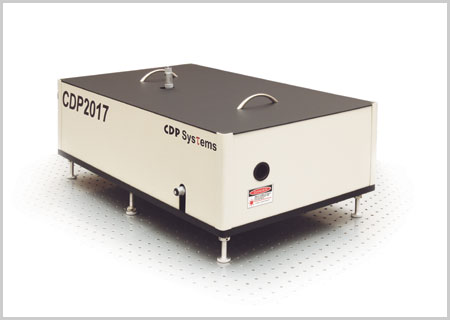
> 30% conversion efficiency from pump pulse to parametric radiation
Wavelength conversion for ExciPro, TAPPIR, FOG 100-DA
Wavelength conversion options for wavelength tuning from 240 nm to 16 mm
Input pulse requirements:
Pump wavelength: 800 ± 20 nm
Pump pulse energy: 0.4 J – 1.0 J
Pump pulse repetition rate: 50 Hz – 5 kHz
Pump pulse duration: < 100 fs
Specifications:
Signal wavelengths: 1140 - 1600 nm
Idler wavelengths: 1600 - 2600 nm
Signal polarization: Horizontal
Idler polarization: Vertical
Conversion efficiency from pump to signal and idler: > 30%
Dimensions: 680 mm x 420 mm x 180 mm
FOG100 Professional Femtosecond Fluorescence Spectrometer 专业级飞秒荧光光谱仪
Femtosecond optical gating (FOG) methods give best temporal resolution in light induced fluorescence lifetime measurements. Since 1997 we manufacture model FOG100-DX for operation with femtosecond oscillators and we offer now FOG100-DA for operation with femtosecond amplified pulses. Completely computer-controlled FOG100 spectrometers are available with new generation compact electronics and LabVIEW based data acquisition software.
<100 fs temporal resolution
Double monochromator for small fluorescence red shift detection
Photon counting and analog / digital modes for PMT detector
Analog / digital electronics for highest dynamic range at 1 kHz
Fluorescence collection with off-axis parabolic mirrors
Patented rotation / magnetically stirred sample holder
Anisotropy measurements with Berek variable waveplate
Computer controlled monochromator, PMT, nonlinear crystal rotation, delay line operation and alignment, xy-translation sample holder, filter wheel
LabVIEW based software for system control and data acquisition
Surface Miner Pro data analysis software
Time-correlated single photon counting (TCSPC) option
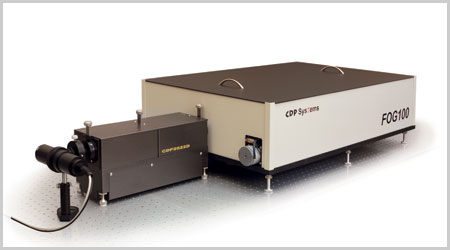
Specifications:
Fluorescence spectral range: 320 nm - 1600 nm
Time resolution: better than 100 fs for thin samples
FOG100-DA input pulse repetition rate: 1 kHz - 10 kHz
FOG100-DX input pulse repetition rate: 100 kHz - 100 MHz
Dynamic range in analog / digital PMT mode: 6x104 (Model DA)
Dark counts in photon counting PMT mode: <2 cps (Model DX)
Spectral resolution: <1.5 nm with 0.1 mm slit
Optical delay line range: 2.0 ns (4.0 ns or 8.0 ns optionally)
Minimum step: 0.52 fs for 2 ns delay line
Automatic phase matching angle resolution: 0.01o
Beam pointing drift for automated delay line alignment: <10 microns
XY-translation sample holder: 12 mm x 12 mm
Data Analysis Software:
Surface Miner Pro makes analysis of emission kinetics and decay association spectra, simultaneous display of kinetics and spectra, 2D and 3D display for dynamic surfaces, averaging of multiple surfaces, quick and easy normalization of kinetics and spectra, subtraction of scattered light and background, anisotropy calculation, chirp correction and time zero adjustment, kinetics deconvolution and fitting at individual wavelengths and global kinetics fitting analysis.
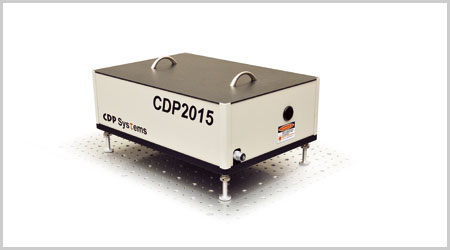
An optional CDP 2015 third harmonic generator is recommended with FOG 100-DX for the UV sample excitation. The second harmonic generator is installed inside the FOG 100-DX optical unit.
ExciPro
Professional Femtosecond Transient Absorption Spectrometer
ExciPro is the first on the market femtosecond transient absorption pump-probe spectrometer. Two linear image sensors are placed in the focal in the focal plane of an imaging spectrograph to measure probe and reference spectra originating from femtosecond white light continuum generator. The reference channel is used in transient absorption measurements to get best optical density (OD) changes sensitivity. New completely computer-controlled ExciPro-XL is available with compact electronics and LabVIEW based data acquisition software.
Professional pump-probe spectrometer with probe and reference channels
<100 fs time resolution
Computer-controlled imaging spectrograph
Femtosecond continuum collection with off-axis parabolic mirror
Patented rotation / magnetically stirred sample holder
Anisotropy measurements with Berek variable waveplate
Computer control of detectors, spectrograph, delay line operation and alignment, pump beam alignment, XY-translation sample holder, UV continuum generator, filter wheel
LabVIEW based software for system control and data acquisition
Surface Miner Pro data analysis software
Confocal Microscope Extension
Extension for transient absorption measurements on nanosecond- microsecond time scale
ExciLite budget femtosecond pump-probe system without the reference beam
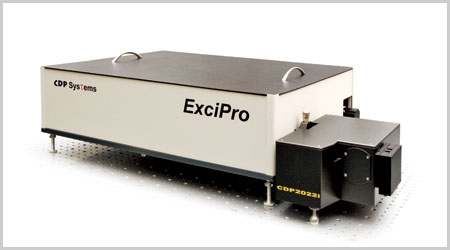
Specifications:
Continuum (probe) spectral range: 320 nm - 1600 nm
Better than 0.1 mOD optical density changes sensitivity (2x10-5 OD typically)
Tine resolution: better than 100 fs for thin samples
Maximum input laser pulse repetition rate: 8 kHz
Spectral resolution: < 2 nm with 0.1 mm monochromator slit
Optical delay line range: 2.0 ns (4.0 ns or 8.0 ns optionally)
Minimum step: 0.52 fs for 2 ns delay line
Beam pointing drift for automated delay line alignment: <10 microns
XY-translation sample holder: 12 mm x 12 mm
Maximum long-time window extension: 0.4 ms
Time resolution for long-time window extension: 1 ns
Optical unit dimensions: 760 mm x 600 mm x 200 mm
Spectrograph dimensions: 320 mm x 200 mm x 160 mm
Detectors:
1024-pixel CMOS or 2048-pixel CCD linear image sensors for spectra detection at 300 nm - 1000 nm
256-pixel InGaAs linear image sensors for spectra detection at 900 nm - 1700 nm
Spectrograph:
Computer-controlled imaging spectrograph with 1-grating or 4-grating turret, aberration corrected configuration and two fiber cables coupled to the input. Two (probe and reference) UV-VIS and two IR linear image sensors are simultaneously mounted into two switchable outputs. The spectrograph can be equipped with high resolution or / and panoramic gratings.
Data Analysis Software:
Surface Miner Pro makes analysis of transient absorption spectra and corresponding kinetics, simultaneous display of kinetics and spectra, 2D and 3D display for dynamic surfaces, averaging of multiple surfaces, quick and easy normalization of kinetics and spectra, subtraction of scattered light and background, anisotropy calculation, chirp correction and time zero adjustment, kinetics deconvolution and fitting at individual wavelengths and global kinetics fitting analysis.
TAPPIR
Femtosecond Transient Absorption Pump-Probe Infrared Spectrometer
Single-channel transient absorption detection in solutions, thin films and solid samples
Detector type: CdHgTe photoconductive detectors cooled with liquid N2
Internal DGF (difference frequency generator)
External CDP 2017 optical parametric amplifier for DFG pumping
Internal second harmonic generator for the sample excitation
ExciPro 2.5 IR software for data acquisition and kinetic analysis
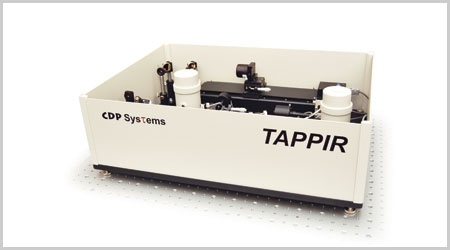
A femtosecond difference frequency generator (DFG) is installed inside the TAPPIR optical unit for the tunable probe of transient absorption within 3 mm - 11 mm. DFG is pumped with signal and idler waves delivered together from an external optical parametric amplifier. Two cooled CdHgTe detectors are used in probe and reference channels, respectively. Femtosecond pulses from an external Ti: sapphire amplifier and CDP 2017 are recommended for the sample excitation.
Specifications
Spectral response range: 3 mm - 11 mm with internal DFG (2.5 mm - 17 mm with external computer controlled DFG)
Detector operation temperature: 77 K
Maximum pulse repetition rate: 5 kHz
Maximum delay between probe and excitation pulses: 2.0 ns (4.0 ns in the optional double-pass configuration)
Minimum step of the optical delay line: 1.56 fs
EPAS (Quartz Enhanced Photoacoustic Spectroscopy) kits
and complete systems
Control and Data processing systems for Diode Laser Spectroscopy
QEPAS is a novel photoacoustic gas detection technique. The key QEPAS feature - using the high-Q quartz resonator as the acoustic signal detector instead of the conventional microphone. This gives new advantages to classic photoacoustic detection principles:
Zero baseline drift for hours
Miniature size of the absorption detection module (ADM)
Superior absorption sensitivity per unit optical path length among all detection methods
Absence of the adjustable elements in the ADM
High dynamic range (from ppb level to 100% concentrations)
The sensitivity is the same as for classic laser photoacoustic spectroscopy technique
Low sensitivity to external acoustic noise
Ultra small gas volume in the sensing element - near 1 mm3
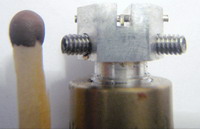
The QEPAS ADM module. The NNEA (Normalized noise equivalent absorption) for NH3 at 1.53 um is 3.3·10-9 cm-1W/Hz-1/2. Ammonia detection limit in the air -
QEPAS method was invented by A.A.Kosterev at RICE Quantum Institute in 2002, and then developed in close cooperation with CDP Systems Corp.
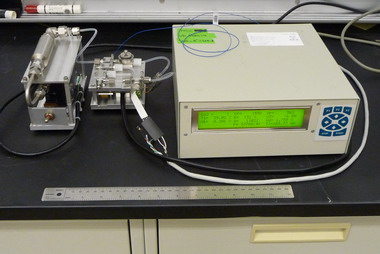
QEPAS gas detector at RICE. CDP Systems QEPAS Control unit (right), gas inlet system (left). Photo by A.A.Kosterev
CPD Systems produces various types of control units for multispecies QEPAS measurements. The control unit includes DFB or QCL laser driver with precision temperature control, low noise modulation signal syntesizer, laser frequency stabilization loop with reference gas cells, 24-bit high-speed ADC, digital lock-in and data logging flash.
Each control unit can support up to 4 reference cells with different gases, one main and 3 additional DFB laser source (or a multichip DFB laser with SOA) and 2 ADM.
Control unit also supports the external Quantum Cascade (QC) mid-IR laser in AM (detection on modulation frequency) and FM (detection on second acoustic harmonic) modes.
The device can be programmed for up to 10 different consecutive measurement modes (laser selection, laser current and temperature, ADM and reference cell selection, absorption line locking mode, MEMS optical switch state, etc.) for different species detection.
The control unit periodically performs automatic zero and ADM parameters (Q-factor, loss resistance, resonant frequency) calibration.
Specifications:
ADM tuning fork frequency range: 5000 - 50 000 Hz
ADM tuning fork Q-factor: 700 - 150 000
Supports DFB lasers in butterfly and TO (optional) cases
Maximum internal and external DFB lasers current: 600 mA
Maximum internal QCL laser current: 1500 mA
Laser chip temperature range: -10 +40 °C
Acoustic signal detection at ADM thermal noise limit
Power supply: universal AC or rechargeable Li-ion cells with the external AC adapter (6+ hours of autonomous work)
Computer interface: serial/USB, protocol compatible with LabView® programming environment
Humidity and temperature sensors for monitoring the gas properties
Programmable operation modes: 10
Supports up to 4 DFB laser sources in one configuration
嗡 哇苏
达咧司哇哈
全国服务热线:
185-021-93480
扫一扫
关注我们




